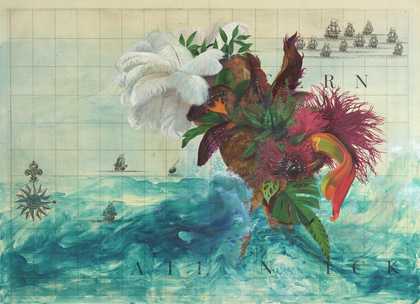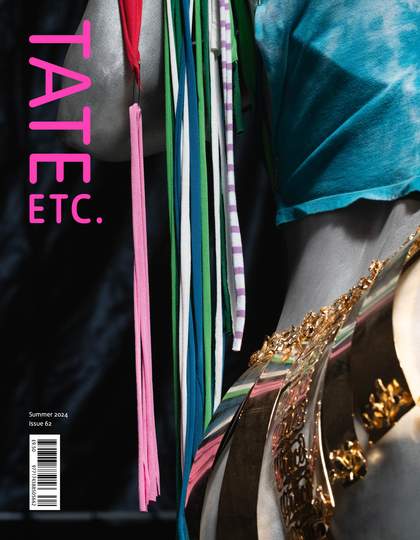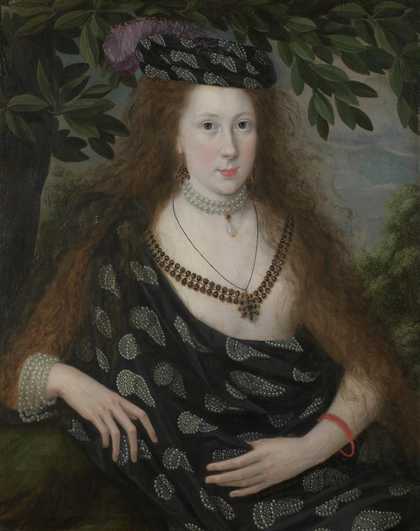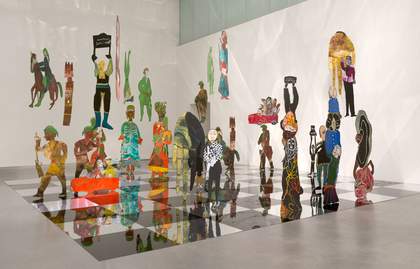
Firelei Báez
Untitled (A Map of the British Empire in America) (2021)
Lent by the Tate Americas Foundation, courtesy of the North American Acquisitions Committee 2021
© Firelei Báez; courtesy of the artist and James Cohan, New York. Photo: Phoebe d’Heurle
Learn the colour of the hours;
and here, in this little case of bones
I’ve left you the perfume of the seas
– Rhina Espaillat
A good myth is recognised by its footprints. It leaves traces wherever it lands. Without a resting place, it’s reinvented elsewhere, its shoots nudging in various directions. Firelei Báez’s Untitled (A Map of the British Empire in America) 2021 steps into these crosswires, its unbridled wildness rubbing up against precision.
Born in the Dominican Republic in 1981, in a market town near the border with Haiti, Báez is drawn to the abiding power of Caribbean mythology. Her paintings, sculptures and installations attest to the embattled landscape of the islands, a place where history rattles loose the foundations of all certainties. At the age of eight, Báez moved to the United States with her family, her ‘rudderless’ childhood informing her fascination with the motile nature of identity. Santo Domingo. Port-au-Prince. Miami. New York. The Caribbean is defined by spillage. Cuban writer Antonio Benítez-Rojo wrote of these repeating islands linking together: ‘a cultural meta-archipelago without centre and without limits’.
The Caribbean lies knee-deep in surrealism, and Báez revels in this vital inheritance, plunging us into her vision of a geography awash with contradiction. Her vast canvas currently hanging in Tate Modern is one example: a mythic chimera superimposed onto a reproduced map drawn up by British cartographers in 1733. A vivid tension between cosmologies pervades.
At the centre of the painting is La Ciguapa, a cryptic figure pulled from Dominican folklore. Ciguapas possess the form of human women, naked except for the sweep of their long hair. They shelter in the island’s mountains and thick forests, frequenting rivers and streams. These blue-skinned beings hark back to Taino folklore and the African diaspora’s Mami Wata spirits, as well as the tales of mermaids brought over by European colonists. Many-tongued sirens emerge from the shadows of myth, in the hills or under the water, luring unsuspecting men across the ages. Ciguapas are nightmarish nymphs, representing the dogged unknowability of the island and the secrets of its beating, untamed heart. The mountains guard this knowledge, much as they protected the rebels and maroons fleeing slavery and relentlessly defending their newfound freedom.
Hispaniola, the island that would be divided between modern-day Haiti and the Dominican Republic, was the site of the first permanent European settlement in the Americas. Upon his arrival on the island’s shores in 1492, the promise of gold whetted Christopher Columbus’s appetite. (His diaries reveal his enchantment by the island’s lushness: ‘in all Castile there is no land which could be compared with it in beauty or bounteousness’). He would return the following year with 1,300 men, establishing the settlement of La Isabela. Depredation and enslavement would become the order of the day, with a brutal regime of violence exacted on the indigenous Taino population and the kidnapped Africans who formed the backbone of the growing plantation economy. Resistance against these horrors was inevitable, and its advent was forceful and bloody. Enslaved workers revolted in 1521, rampaging through the sugar estate owned by the colonial governor Diego Columbus, the eldest son of Christopher Columbus, raiding the wealth they had built and delivering vengeance.
‘Definitions, origins, timelines; all are contested on the canvas, blown up into a sublime wall of feather and seafoam.’
Coinciding with Christmas, this uprising marks the earliest recorded slave rebellion in the Atlantic World. By the end of the week, the insurrection was crushed, though many of the rebels managed to escape to the hinterlands. These remote mountain ranges continued to nurture communities of maroons, serving as fortresses, places of refuge and incubators of a distinct culture transmitted across generations.
Báez sees the Ciguapa as a symbol of unrestrained freedom. Adorned in plumes of feather and foliage, her creatures are irrepressible enigmas. They, too, make a home out of the mountains. Rising from a pit of devastation, the Ciguapa in Untitled (A Map of the British Empire in America) is an ambush of colour: greens, pinks, dusky oranges. A map of conquest serves as its backdrop, with the island of Bermuda as the focal point. Dotted ships loom within touching distance, an encroaching spectre of Empire. These ships are harbingers of fateful severances, and the scene itself is surrounded by the disfigured Atlantic, ‘the blue closing over’ as the Jamaican poet Edward Baugh imagined it, its waters raging, frothing and spitting out ancestral reverberations. A compass floats like an ident. The Ciguapa’s feet face backwards, as they do in the folktales. In looking backwards, she imposes herself on history. Things fall apart, resurfacing in peculiar, haunting ways. We lose our bearings.
In this sense, Báez is a cartographer of the adrift. She keeps to Caribbean Standard Time, a zone of stubborn mutability. The direction of the wind, and all it carries, can’t be relied upon. Resourcefulness can be a useful weapon in one’s arsenal. Since childhood, Báez would repurpose any fabrics and materials she could find in her art. ‘Building up is an anchoring’, she explains in an interview with the art historian Tashima Thomas, describing the compositional approach she developed as an artist.
Faced with Untitled, I found myself gripped by the convergence of oral and official archives it portrays. Definitions, origins, timelines; all are contested on the canvas, blown up into a sublime wall of feather and seafoam. Báez has spoken about the intended physicality of her large-scale pieces, and it’s this vastness of scope and silence which disarmed me. I think of the poet Kei Miller defining the cartographer’s job as a ‘widening of the unfamiliar’ and the marking of an island’s ‘latitude of mysteries’, tasks that involve a confrontation with the ungraspable. After all, the landscape, as Miller reminds us, doesn’t sit willingly behind an easel.
Báez’s mythical figures take flight, offering no easy landings. They are buoyed by history, not weighted by predictable truisms or simplistic divisions between victims and victimisers. This is your story too, the painting insinuates. This too is your wreckage.
Untitled (A Map of the British Empire in America) was lent by the Tate Americas Foundation, courtesy of the North American Acquisitions Committee in 2021 and is included in the free display Artist and Society at Tate Modern.
Momtaza Mehri is a poet and essayist who lives in London. Her book Bad Diaspora Poems won the Forward Prize for Best First Collection.



